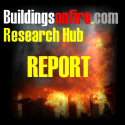NIST Wind Driven Fire Simulation Video
By Christopher J. Naum, SFPE on Jan 29, 2011 with Comments 0

NIST Wind Driven Fire Simulation Video
Wind Driven Fires
Smoke and heat spreading through the corridors and the stairs of a building during a fire can limit building occupants’ ability to escape and can limit fire fighters’ ability to rescue them. Changes in the building’s ventilation or presence of an external wind can increase the energy release of the fire. This can also increase the spread of fire gases through the building. In some cases, such as the Cook County Administration Building fire in October 2003, the fire gas flow, into the corridors and the stairway prevented fire fighters from suppressing the fire from inside the structure. This fire resulted in 6 building occupant fatalities and fire fighter injuries in the stairway. The Fire Department of New York City has experienced many wind driven fire incidents which have resulted in fire fighter fatalities and injuries.
What tactics or tools are appropriate for use with a wind driven fire and how should the tactics or tools be implemented? Positive Pressure Ventilation (PPV) is being used by fire departments on smaller structures, such as single family homes, to control the fire flow by introducing pressure from the front door and venting the house through a strategic exit opening. If done correctly, this tactic can remove significant amounts of heat and smoke from the structure, thus improving the fire fighters’ working environment and improving the chances of survival for the building occupants. NIST has completed several studies which have a two fold impact: 1) providing guidance on the safe use of PPV and 2) characterizing and validating the modeling of PPV with a computational fluid dynamics (CFD) computer model, so that the model can be used as a training tool for the fire service.
This project extends previous work for ventilation under wind driven conditions. There are many questions regarding wind driven fires. For example can these PPV fans be used successfully under wind driven fire conditions in large structures? Large structures, such as high rise buildings, provide additional challenges to fire fighter and building occupant safety: increased travel distance (exposure time), more complicated egress path, and potentially larger fires. In 2002 there were 7,300 reported fires in high rise structures.
Other tactics incorporating devices, such as wind control devices (WCD) to control the ventilation conditions or the use of a “high rise” nozzle from the floor below the fire floor have been tried by the fire service under “real fire” conditions with varying levels of success. Unfortunately, there is no data to understand the capabilities and limitations of these fire fighting approaches. This effort will address this need for real scale data, to guide the development of appropriate tactical operations for use under wind driven conditions.
Fire Fighting Tactics Under Wind Driven Conditions: Seven-Story Building Experiments Link Here
Filed Under: Anatomy of Buildings • Fire Dynamics & Behavior • Multi-Media Center • Research • Research Hub • Training Division • Videos























